
Both the content of this page and its referenced pages will be changing and you are encouraged to check back.
Design Note: I am a designer and care about how anything, including information, is presented. The "look" of these pages is intentional: retro plain HTML. Because retro is fun and consistent with the retro-info that it conveys.
Portfolio of notable projects referenced in resume | Digital video of CDR projects
Company AuSIM
The World Wide Web
The World-Wide-Web became popularized with the rise of NSCA's Mosaic browser, first released in 1993. The Center for Design Research created a WWW server ("cdr.stanford.edu") in 1992, as WWW server #39 on the Internet. W. Chapin's DesignSpace and Virtual Space Exploration Lab were relatively the first research projects ever published on the WWW. At the same time the WWW diverted all of the public enthusiasm (and therefore financial interest) away from VR, AR, and telepresence techologies.Years after W. Chapin left CDR, CDR was coerced into conforming its web-server third-level domain to begin with "www". Thus all CDR projects were moved to www-cdr.stanford.edu, which currently redirects to the modern-day https address under Stanford ME. However, CDR did not move these pre-2000 projects to the new ME site. They actually still exist: DesignSpace and Virtual Space Exploration Lab. Unfortunately, some of the links are broken from this 25 year history.
These sites have been restored on AuSIM's web server: DesignSpace and Virtual Space Exploration Lab.
Videos related to the CDR projects have been restored and collected here.
Robotic Farming
With the current politi-economic climate in the US, limiting immigration and raising minimum wage, combined with the ever increasing value of land (and necessary associated Return On Investment), something must drastically change in US agriculture.The Silicon Valley tech answer is: autonomous farming robots.
Unlike the common assumption, tech in agriculture is not new. Enter the story of DICKEY-john.
Interesting fun fact of the day:

The image at left shows Bill displaying a blue ribbon won at the county fair.
A few notes here:
- Angus was a minority breed in the USA back in the 60's and 70's. Bill did his research and found that Angus meat was more tender and consumer desirable versus the Hereford, Shorthorn, Galloway, Brahman, and Charolais, which were all more popular because of their faster growth and larger size. Larger size equated to more money at the livestock market, all other things being equal. Bill bet that he could get a premium price for his Angus at the scales. Today, Angus is the only breed you will find specified on a menu. He was visionary before his time.
- Research continued into exactly what lineage of Aberdeen Angus Bill wanted. He located a breeder about 60 miles away that had stock he liked the looks of. When Bill visited hime on weaning day, the breeder said he could have any heifer he chose for $175. There were about 40 to choose from. When Bill singled one out, the breeder said "Except that one, she is exceptional. She'll be $250." Bill had a good eye for good breeding stock at age 9.
- One needs to mow a lot of acres of pasture, stack a lot of hay, and fix a lot of miles of fenceline at $1 per hour to save enough money to buy a weanling pure-bred heifer.
- One needs to be a pretty big 8 year old to stack hay and pull fence wire.